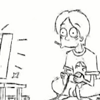Designing:
- Start with basic shapes. Shark from Finding Nemo starts out from half a circle.
- Play with proportions and contrast in all x,y,z axis. Ten 1:1:1 (head:body:leg) characters are boring.
- Add details that help define, not confused.
- Pay attention to flow and tension within your design.
Animating
- Get your camera right before you starts animating.
- Clear and concise anticipation, action and follow-through pose and timing. Draw them out even if you are animating in 3D. Come up with different poses and play with timing before you animate.
- Think of the line of action and its motion. Animate character as if you are animating a stick figure. Use arc, C shape, S shape and straight line to your advantage.
- Varies your motion speed to make it more interesting. (ex: slow slow fast slow...)
- Heavy thing has longer slow in and slow out, and create bigger impact.
- Elastic thing has more follow through. (Arm vs. Torso)
- Eyes move before head, head before body.
- Add secondary motions to make your character more alive (finger, etc.) but make sure they remain secondary.
- Before you rig, know your character's center of balance. (Man at pelvis. Woman at hip.)
- First and last words is the most important in Lipsync. Next priority would be words with P, M, E, and O. Get the rest as close as you can without loosing face emotion.
- Convey story and emotion, not your animating skill.
Lighting
- Color tint your shadow, don't use pure black.
- Eyes have limited exposure range. Use it to create illution of light.
- Beware of color relation. Lots of red will make all other colors look greener.
- Think about time and temperature. (Blue tint in the morning, even light at noon, orange at evening, stronger shadow in day, warmer light in summer, etc.)
- Add individual lighting to help boost specific object's form and matterial definition. Global lighting sux and HDRI is cheating.
- Blue object absorbs all other colors in light except blue, leaving the bounce light blueish. More saturate and brighter color object bounces off more light.
- Far objects tend to lose their color saturation.
- Use mask for light in big area to create uneven lighting and the illusion of atmosphere.
